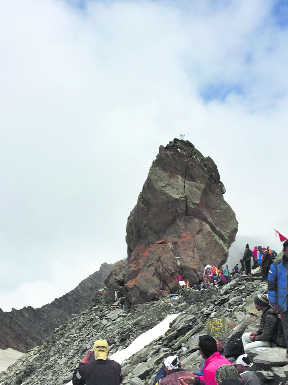Even before we set out for the Shrikhand Mahadev yatra, a fear seemed to stalk us: Chandigarh’s trekker boy on the same route, Abhishek Kharbanda (23), was reported missing since July 3.
Not a good omen to hoof it to one of the toughest treks of the country perched at a height of 16,500 ft. For the five of us, the fear gave way to planning it all right.
July 15: We hit the road to Lord Shiva’s abode, Shrikhand. It was my second trip; the first one was a failure in 2015. After a daylong drive, we reached Jaon village near Nirmand town. Though tired, we decided to trek to Singhad, the first camp site 3km from Jaon, in the evening to get a head-start the next day. Once there, we heard the tales of devotees returning from Shrikhand. Their stories of imposing mountains and slippery glaciers awed us.
July 16: We were up early. A 12-km trek to Thachru, the second camp site, lay ahead. With raincoats on, we set out. The path was steep and winding. We soon realised why the path to Thachru is called ‘danda dhaar.’ Such was the steepness that I dared not look up; my gaze was limited to the feet of the person ahead.
My friends were asking the returnees: “Kitna reh gaya (how much more left to walk on)?” A few surmised two hours, while some said we had almost made it. My little trekking experience has taught me not to trust the sense of time of Himachalis. We cannot match their pace. They ascend fast and descend faster. So, this time, I made it a point not to ask for the distance.
Abhishek figured in our conversations wherever we stopped to catch our breath. At one such stop, someone told us his mother was in Singhad, hoping against hope that her son would return.
“Can we reach Bheem Dwar?” hollered a friend. “Why not,” came the response from whoever bothered to hear him. Bheem Dwar is the third camp site, 11 km from Thachru. Reaching there would have meant a 23-km walk in a day. Better sense demanded that we halt at Thachru at 1.30 pm. If doubts were beginning to cloud our minds, rain that started half-an-hour later cleared everything.
July 17: The plan was the same: get up early and reach the camp site by afternoon before it starts raining. We were at Bheem Dwar around 1 pm. What lay ahead was the toughest part of the trek. Not many reach the summit. I had heard stories of pilgrims returning 100m short from the summit.
July 18: At 3.40 am, we started the final ascent. The plan was to remain together — not to lose sight of each other. It was in this area that Abhishek disappeared, apparently separated from his friends, and lost track. With “Har Har Mahadev” on our lips and torches in our hand, we joined the countless devotees. After crossing about five streams, clouds opened up. The five of us did not stop. When we were soaking wet, we stopped at Parvati Bagh.
We waited for the rain to stop. But clouds were in no mood. About two hours later, a rescue team called off the yatra for the day. After several revisions, we decided to give it another shot, subject to weather conditions, in the morning.
July 19: The sky was clear. At 5 am, we were off to Shrikhand Mahadev. The 9-km path was treacherous — a muddy track gave way to a rocky path and then to a glacial landscape — all this on the way to a steep climb.
Breathing was a problem and a mild headache was a constant companion. After five hours of back-breaking trek, we were finally at the “shilla”, about 80-ft stone from where Lord Shiva is said to have appeared.
I was overwhelmed. My eyes welled up: I was a speck in the vastness of space; a non-entity. We remained there for an hour, ruminating. A day after returning home, we came to know that Abhishek’s body had been found. He was on his way down when he lost track and slipped into a gorge.
Unlock Exclusive Insights with The Tribune Premium
Take your experience further with Premium access.
Thought-provoking Opinions, Expert Analysis, In-depth Insights and other Member Only Benefits
Already a Member? Sign In Now










